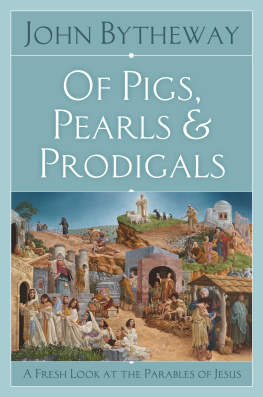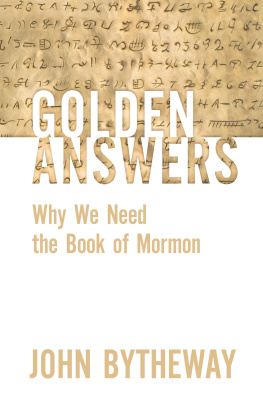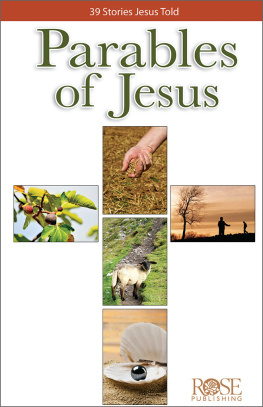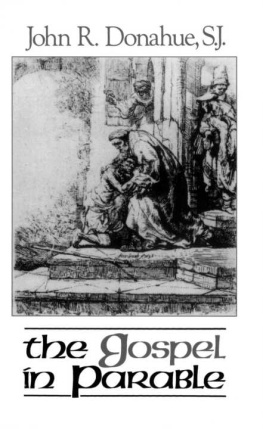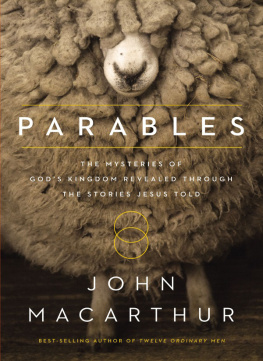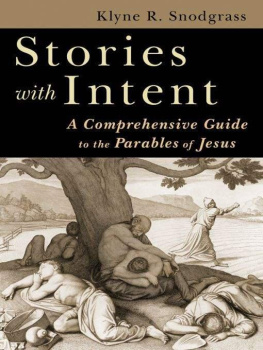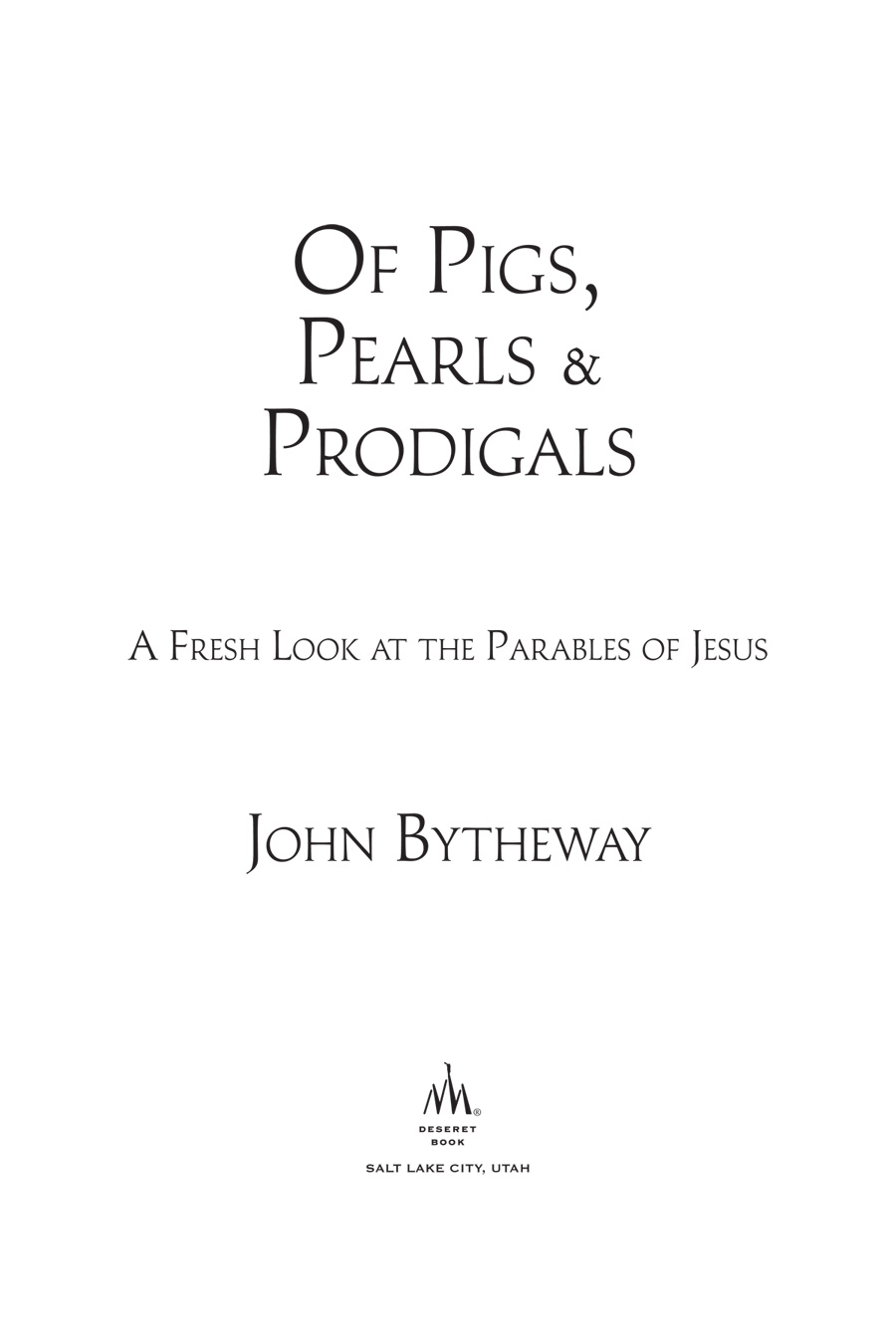2010 John Bytheway.
All rights reserved. No part of this book may be reproduced in any form or by any means without permission in writing from the publisher, Deseret Book Company, P.O. Box 30178, Salt Lake City Utah 30178. This work is not an official publication of The Church of Jesus Christ of Latter-day Saints. The views expressed herein are the responsibility of the author and do not necessarily represent the position of the Church or of Deseret Book. Deseret Book is a registered trademark of Deseret Book Company.
Library of Congress Cataloging-in-Publication Data
Bytheway, John, 1962
Of pigs, pearls, and prodigals : a fresh look at the parables of Jesus / John Bytheway.
p. cm.
Includes bibliographical references and index.
ISBN 978-1-59038-808-2 (hardbound : alk. paper)
1. Jesus ChristParables. 2. Church of Jesus Christ of Latter-day SaintsDoctrines. 3. Mormon ChurchDoctrines. I. Title.
BT375.3.B98 2010
226.8'06dc22 2010040028
Printed in the United States of AmericaPublishers Printing, Salt Lake City, Utah
10 9 8 7 6 5 4 3 2 1
Image credits:
Chapter opening illustrations throughout, Owen Richardson; p. viii, Mike Loveridge; pp. 3, 28, 141, 173, D. Kelly Ogden; pp. 5, 142, 147, Don Busath; p. 15, Northern Illinois University; pp. 34, 53, 77, 83, 195, 203, 209, Thinkstock; pp. 35, 39, 43, 146, Dan Burr; pp. 38, 92, 109, 122, 162, Jim Gee; p. 65, Shutterstock; p. 94, Deseret News; p. 110, Museum of Church History and Art; p. 116, Deseret News; p. 157, Kimberly Bytheway.
Introduction
Recently, my wife and I had the once-in-a-lifetime opportunity to visit the Holy Land. We toured many places, including Bethlehem, Nazareth, Jericho, the Sea of Galilee, Jerusalem, the Garden of Gethsemane, and, of course, the Garden Tomb. As we beheld in high definition the backdrop for the life and teachings of the Savior, aha experiences came by the dozen.
What had before been a mere interest in the parables became a fascination, even an obsession. I couldnt wait to get home, do additional reading and research about these marvelous teaching stories, and share my findings with others.
As you may know, Matthew, Mark, and Luke are often called the synoptic gospels, synoptic meaning same-eye. They all move along in a similar way and are easily harmonized (theres a chart in the Bible Dictionary that shows this harmony of the gospels). The book of John is quite different, on the other hand; it is not one of the synoptic gospels and the imagery it contains is not in parable form. Many of the parables appear in all three of the synoptic gospels, some in two, and some are unique to their own book.
I have chosen to list the parables as one would encounter them by reading Matthew, Mark, and Luke in order.

John and Kim Bytheway in Jerusalem
Each chapter begins with a who, where, and why section so that we know who Jesus was talking to, where the parable was being taught, and why he was teaching it. Joseph Smith gave a very helpful suggestion for interpreting parables when he said, What was the question which drew out the answer, or caused Jesus to utter the parable?... To ascertain its meaning, we must dig up the root and ascertain what it was that drew the saying out of Jesus (Teachings, 27677).
Interpretation and application are different things. The Bible Dictionary states: It is important to distinguish between the interpretation of a parable and the application of a parable. The only true interpretation is the meaning the parable conveyed, or was meant to convey, when first spoken. The application of a parable may vary in every age and circumstance (s.v. Parables, 741). Youll find a Therefore, what do I do? section at the conclusion of each chapter that suggests some ways to apply the scripture to our lives.
My goal for this book is to be:
Complete. (Ill cover more than thirty parables using a broad definition of such, and Ill include the scriptural text.)
Concise. (I wont wax eloquent or try to dazzle you with brilliancesince I have none.)
Conversational. (Ill keep it light, Ill keep it moving, and we might even laugh on occasion.)
Ive included a list of recommended reading at the end of the book in case youd like to explore the parables in more depth.
A Wise Man, Which Built His House upon a Rock
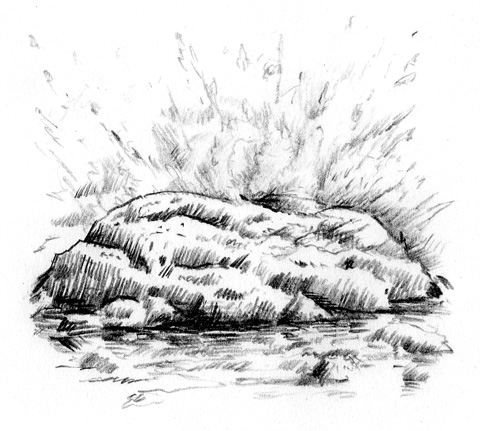
Fred H. Wight: Expert masons have always been in demand in Bible lands through the years.... In building foundations it is important to get down to rock or otherwise the shrinkage and expansion due to the summer heat and the winter rains will do damage to the construction. Jesus tells of a good mason who digged deep, and laid the foundation on a rock (Luke 6:48). Deep trenches are dug, and filled with stone and lime, and this is allowed to settle all it will (Manners and Customs, 217).
Chapter 1
The Parable of the House Built Upon a Rock
Matthew 7:2427; Luke 6:4749
Who: Multitudes gathered to hear the Sermon on the Mount
Where: Galilee
Why: Concluding the Sermon on the Mount, Jesus likens those who hear his sayings to houses built upon rock or upon sand, depending on whether they become doers of the word or hearers only (see Matthew 7:2123)
Matthew 7:2427
Therefore whosoever heareth these sayings of mine, and doeth them, I will liken him unto a wise man, which built his house upon a rock:
And the rain descended, and the floods came, and the winds blew, and beat upon that house; and it fell not: for it was founded upon a rock.
And every one that heareth these sayings of mine, and doeth them not, shall be likened unto a foolish man, which built his house upon the sand:
And the rain descended, and the floods came, and the winds blew, and beat upon that house; and it fell: and great was the fall of it.
Commentary
Matthew 7:24 Therefore whosoever heareth these sayings of mine, and doeth them, I will liken him unto a wise man, which built his house upon a rock
We usually think of Joseph and Jesus as carpenters who worked with wood, but perhaps they also worked in stone. Wood wasnt as readily available as stone in the Holy Land. The Greek word translated as carpenter is tekton, and means artificer or craftsman, which could apply to either wood or stone.
Dr. D. Kelly Ogden observed:
[Joseph and Jesus] could just as well have been artificers or craftsmen of stone, which was much more available and used in the building trades. Note that the imagery in Jesus teachings frequently includes the use of stone in building. (See, for example, Matt. 7:2425; 16:18; Luke 14:2830; 20:1718) (Where Jesus Walked, 98).
Its also interesting to note that the ancient city of Sepphoris was only six kilometers away from Nazareth, and it was in the process of being rebuilt at the time of Jesus, so the images of stones, buildings, and foundations would have been familiar to the people of the area.
Matthew 7:25

